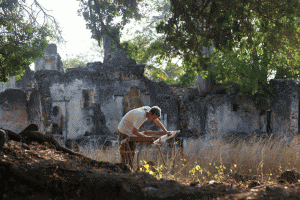An Indian text commonly referred to as The Bakhshali Manuscript is documented as the oldest record of the concept of zero and it was believed to be originally from the 9th century. However, the document was recently tested at the University of Oxford Radiocarbon Accelerator Unit and the results determined that The Bakhshali Manuscript is from 224-383 AD.
Radiocarbon dating is a technique used by archaeologists to determine the approximate age of an artifact and or ecofact. It measures the radioactive decay of carbon-14, which is found in all organic material. It is the most common and reliable absolute dating technique. Researchers were able to use radiocarbon dating on The Bakhshali Manuscript because it was made out of birch bark, an organic material. However, it was difficult to determine the true age of The Bakhshali Manuscript because the 70 page document is composed of materials from three different time periods. When the University of Oxford tested the document with their Radiocarbon Accelerator Unit they used three different samples and each sample came from a different century. One sample came from 885-993 AD, another from 680-779, and the most shocking from 224-383 AD. There may be more information on why The Bakhshali Manuscript comes from three different time periods but, an official report of the results have not yet been published.
There is little information on how The Bakhshali Manuscript was discovered. Researchers do know that the document was found in 1881 by a farmer in Bakhshali, a small village in Pakistan, buried in a field. In 1902, The Bakhshali Manuscript was transferred to The Bodleian Library at Oxford University. Translations of the Sanskrit text on the document reveal that it was a reference book for traders on the Silk Road. The Bakhshali Manuscript contains simple arithmetic exercises, most likely for determining profitable exchanges. It are these exercises where the zeros, which are used as place holders and found as solid dots, are located . It is a shame that there is no context recorded of the site where the manuscript was discovered and perhaps more artifacts are waiting to be found. However, there is still a lot to learn from the document itself.
The new discovery of The Bakhshali Manuscript’s true age reveals how cemented the idea of zero was in India. It is challenging to image a world without zero, but many cultures, especially European found it difficult to adopt this new concept. India has had a long religious history of contemplating nothingness. Marcus du Sautoy, a professor of mathematics at the University of Oxford, believes that this is why the concept of zero might have been influenced through cultural practices. Du Sautoy stated, “This [The Bakhshali Manuscript ] is coming out of a culture that is quite happy to conceive of the void, to conceive of the infinite.That is exciting to recognise, that culture is important in making big mathematical breakthroughs.” The Bakhshali Manuscript is a remarkable artifact that demonstrates the interwoven relationship between complex math concepts and culture.
Additional Readings
http://www.abc.net.au/news/2017-09-15/ancient-indians-used-zero-earlier-than-previously-thought/8949890
http://economictimes.indiatimes.com/news/politics-and-nation/ancient-indian-text-pushes-back-history-of-zero-by-500-years/articleshow/60524162.cms
Sources
“A Big Zero: Research Uncovers the Date of the Bakhshali Manuscript.” YouTube, University of Oxford, www.youtube.com/watch?v=pV_gXGTuWxY&feature=youtu.be.
“Carbon Dating at Oxford University Finds Bakhshali Manuscript Contains Oldest Recorded Origins of the Symbol ‘Zero’.” Fine Books, 14 Sept. 2017, www.finebooksmagazine.com/press/2017/09/carbon-dating-at-oxford-university-finds-bakhshali-manuscript-contains-oldest-recorded-origins-of-th.phtml.
Devlin, Hannah. “Much ado about nothing: ancient Indian text contains earliest zero symbol.” The Guardian, 13 Sept. 2017, www.theguardian.com/science/2017/sep/14/much-ado-about-nothing-ancient-indian-text-contains-earliest-zero-symbol.
Renfrew, Colin, and Paul Bahn. Archaeology Essentials. London, Thames & Hudson, 2015.
Picture Sources
The Bakhshali Manuscript. media2.intoday.in/indiatoday/images/stories/zero-xl_091517122744.jpg.
The University of Oxford Radiocarbon Accelerator Unit. www.arch.ox.ac.uk/rlaha.html.





















